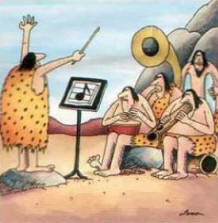
Music and art were probably the first ways ancient man communicated (before a spoken or written language).
Very early man used various percussion instruments, and flutes from the Paleolithic era (about 20,000- 15,000 B.C.) have been found.

| Unit 4- Early Music | The Medieval World You are here |
Gregorian Chant | The Renaissance | Renaissance Composers | Assignments |

|
The First Music Music and art were probably the first ways ancient man communicated (before a spoken or written language). Very early man used various percussion instruments, and flutes from the Paleolithic era (about 20,000- 15,000 B.C.) have been found. |
 |
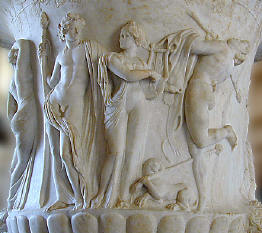
Ancient Greek Music
Music in the ancient Greek world was thought be of 'divine origin' and was created and played by the Greek gods including Apollo and Orpheus. Our term for music itself is derived from the Greek term Mousike, which means "the art of the muses." From the earliest of times, music has been an important part of religious ceremonies. The Greek followers of Apollo played the kithara (a stringed instrument), strumming the 5 to 7 strings to accompany the reciting of epic poems. Followers of Dionysus would play a reed instrument called an aulos.
Starting in the sixth century B.C., both the kithara and aulos were played as independent solo instruments. Contests between musicians were popular during the fifth century B.C., and the music played became complex. The philosopher Aristotle warned against the move from music accompanying poetry to playing music in a 'professional' way:
"The right measure will be attained if students of music stop short of the arts that are practised in professional contests, and do not seek to acquire marvels of execution"
The ancient Greek 'doctrine of ethos' attributed ethical powers to music and claimed that music could affect character. Because music imitates passions (anger, gentleness, sorrow), when one listens to that music you take on those characteristics. In other words, listening to the right kind of music made you a better person, listening to the wrong type could make a person a 'bad person'.
There were 3 traits to early Greek music:
The greatest gift to western music from the Greeks was not their music itself, but rather their theory of music. The great Greek mathematicians Pythagoras and Ptolemy & philosophers Aristotle and Plato saw music as a part of their studies of mathematics, astronomy, and the nature of life. Plato gave us the phrase "the music of the spheres" referring to the connection between music and the heavens.. Music was an important part of the Greek way of life.
Ancient Roman Music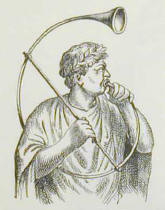
The Romans took most of their music from the Greeks. They did develop, chiefly for military purposes, brass instruments such as trumpet and horn like instruments. Music was considered to be an important part of a 'cultivated' Roman citizen. Many of the emperors were patrons of music; Nero was a famous musician (fiddling while Rome burned). Romans held grand musical festivals and competitions. However, the Roman Empire did not make any significant original musical contributions.
On YouTube | click here for Closed Caption | click here if video above is blocked | transcript of video
The Early Christian Church
The music of the early Christian church rejected many of the Greek and Roman characteristics: Music was not seen as an art form, purely for enjoyment sake, but rather as an expression of faith, praise &/or prayer. The large public concerts (Greek Plays and Choruses and Roman festivals and competitions) were regarded unsuitable by the Church. However, this refrain from public concerts probably had less to do the dislike of concerts as from the need to disassociate music with its' pagan past.
Much of the early Christian church music was influenced by Jewish traditions. The Jewish synagogue services included readings from holy books, psalms, hymns, prayers and almsgiving - all were incorporated into the service music of Christians. In addition, Christian service music imitated the Jewish tradition of call and response. In the Jewish tradition, a cantor would sing one line of a psalm verse and the people would respond with the next. In Christian services this style was known as responsive psalmody.
On YouTube | click here for Closed Caption | click here if video above is blocked | transcript of video
An important contribution of the early church was the hymn. A hymn is a poem in strophic form, all the stanzas intended to be sung to the same melody that is simple and tuneful. These hymn tunes were intended for a congregation of ordinary people, not a trained choir or soloist. Many of the tunes were probably popular folk songs or secular melodies of the day. Another element borrowed from the Jewish service was the use of "Amen" or "Alleluia" endings. These ending refrains became very florid and drawn out.
Prior to rule of the Roman emperor Constantine, Christian services were small, private affairs and therefore each sect developed their own styles and forms. In 313 A.D. Constantine recognized the Christian (Catholic) church and the church emerged from it's underground life and started to gain converts, riches and power. In the fourth century Latin replaced Greek as the language for songs and text. Larger churches and more participants required more formal services and led to the need for trained church musicians.
The Dark Ages
In AD 476, warriors attacked the city of Rome and ended more than 800 years of Roman Rule. Historians mark the fall of the Roman Empire as the end of ancient history. The next one thousand years were called the Middle Ages.
The Latin term for Middle Ages is "medieval." The beginning of the Medieval Times is also known as the "Dark Ages" because the great civilizations of Greece and Rome had fallen. The government that had built roads and aqueducts, maintained law and order, fostered trade and funded great civic projects was gone. The western world just stagnated for a century - no great inventions, little great art, music or architecture.
On YouTube | Click here if the video above is blocked | transcript of the video
Life in Western Europe during the Middle Ages was very hard. Very few people could read or write and nobody expected conditions to improve. The only hope for most people during the Middle Ages was their strong belief in Christianity, and the hope that life in heaven would be better than life on earth. In the mid 13th century the "Black Plague" wiped out almost half of the population of Europe.The morality rate of the Covid-19 pandemic was about .27% - this means for every 1000 people on earth about 3 people die from the disease. From 1347 to 1351 in Europe, a little less than half of all people died from the Plague. Imagine what it must have been like to have a disease that killed just about every other person within a four year period!
Medieval Music - Vocal
The first attempts at harmony was a technique called Organum. The same melody is sung by two people, but each starts on a different note. Thus, the notes parallel each other, usually with the second voice a fourth or fifth below the first voice. Soon, composers began writing parts that did not mirror each other, each part had a separate melodic structure. But it was still note for note; both melody lines were rhythmically the same. Since both voices moved at the same time, a certain rhythmic freedom could be allowed. Before composers could start writing rhythmically different parts a more precise method of notating rhythm would need to be invented.
![]() Organum - Resonemus hoc natali
Organum - Resonemus hoc natali
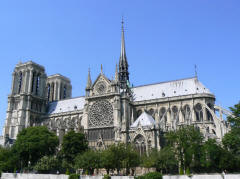 The First Named Composers
The First Named Composers
The first composers of polyphonic music known by name were choirmasters at the church of Notre Dame in Paris (which became the Notre Dame Cathedral). Their names were Leonin and Perotin (1183?-1238?). Perotin added a third and fourth voice to his organum (called triplum (three voices) and quadruplum (four voices)). The melody was always stretched out to very long notes sung by the lower voice (this low voice part was named Tenor, from the Latin word tenere, meaning to hold). Although the other voices usually stayed above the melody in the tenor part, these upper parts began to become independent musical lines with their own melodies and rhythms, and sometimes dipped below the notes in the tenor part.
On YouTube | Click here for Closed Caption video | Click here if the video above is blocked | transcript of video
Medieval Instrumental Music
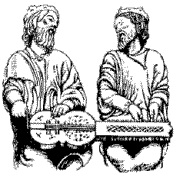 |
Because the early Church did not allow instrumental music, the majority of music before 1300 was vocal. However, starting in the fourteenth century song and dance were accompanied by instruments. Medieval instruments included the harp and fiedel (which would become the modern violin). |
On YouTube | Click here for closed caption video | Click here is video above is blocked | transcript of video
You can listen to examples of Medieval Instruments at: http://www.ltscotland.org.uk/learnlisteningonline/higherandadvancedhigher/musicalperiods/renaissanceperiod/instrumentalmusic.asp
| Assignment #1 - Medieval Instruments Report
Visit this website to investigate medieval instruments: https://www.music.iastate.edu/antiqua/instruments View the Scoring Rubric to see the expectations for the assignment: Click here to view a previous student's work: |